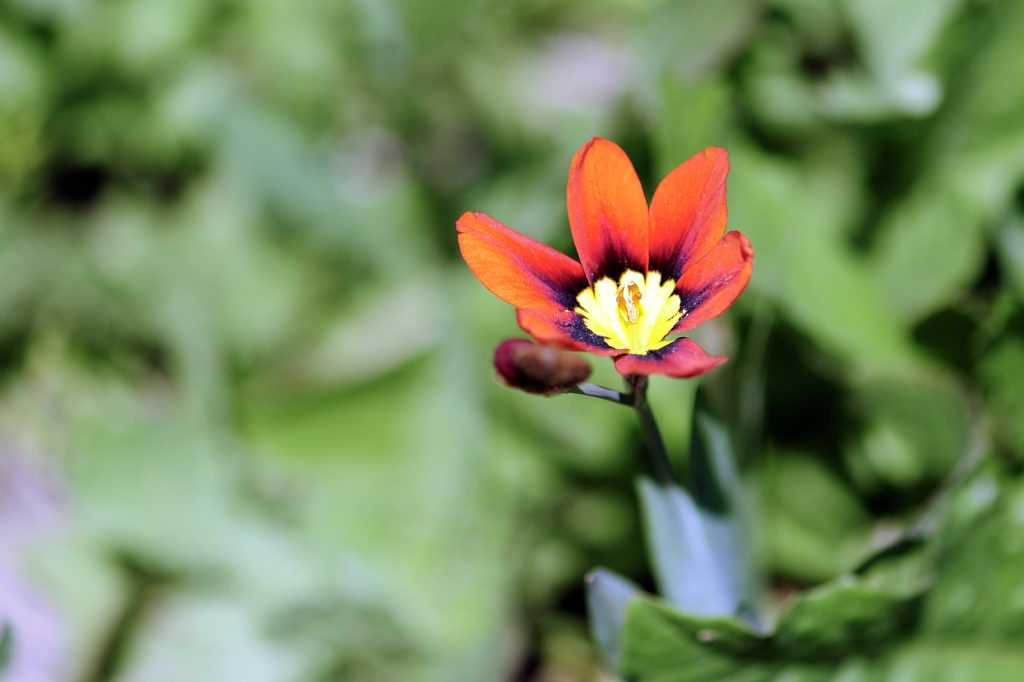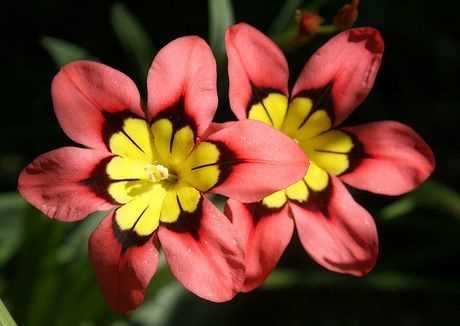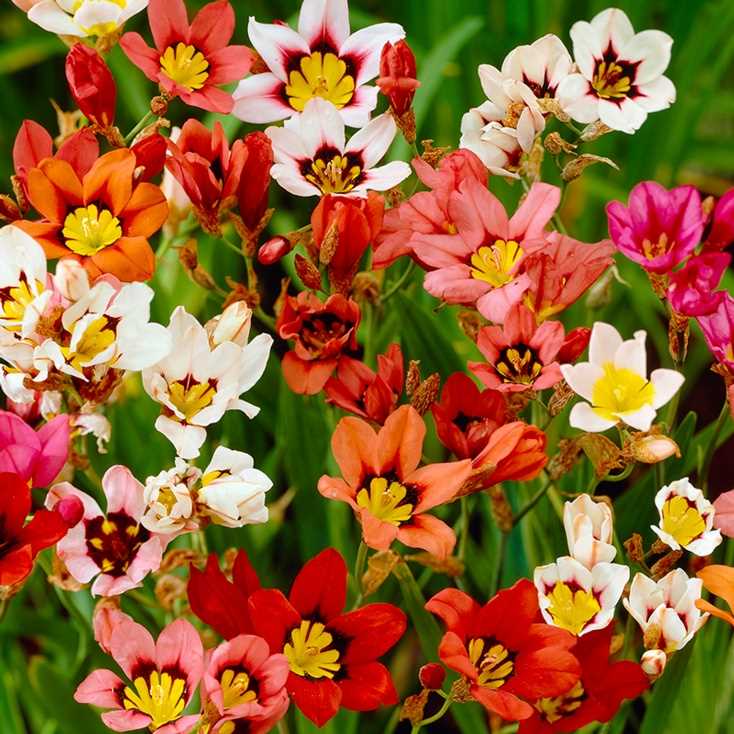- Choosing the Right Location
- Soil Preparation
- Planting Sparaxis Bulbs
- 1. Choose a Planting Location
- 2. Prepare the Soil
- 3. Dig the Planting Holes
- 4. Plant the Bulbs
- 5. Mulch and Water
- 6. Care and Maintenance
- Watering and Fertilizing
- Mulching
- Benefits of Mulching
- How to Mulch
- Pest and Disease Control
- Pest Control
- Disease Control
- Supporting Growing Plants
- Staking
- Trellising
- Supporting Bulb Growth
- Protection from Wind and Heavy Rain
- Sparaxis Care in Winter
- 1. Protection from Frost
- 2. Adequate Drainage
- 3. Regular Inspections
- 4. Minimal Watering
- 5. Good Air Circulation
- 6. Storage
- Questions and Answers:
- What type of soil is best for growing Sparaxis?
- When is the best time to plant Sparaxis corms?
- How often should Sparaxis plants be watered?
- What is the blooming period of Sparaxis?
- Can Sparaxis be grown in containers?
- How do you propagate Sparaxis?
- Videos: Freesia Flowers – How to Grow and Multiply!
Sparaxis, also known as Harlequin Flower or Wandflower, is a colorful and vibrant perennial that adds a touch of beauty to any garden. Native to South Africa, Sparaxis is loved for its striking flowers that come in a wide range of hues, including red, orange, yellow, and purple. This article will provide you with some tips and guidelines on how to successfully grow and care for Sparaxis in the open ground.
Firstly, it is important to choose a suitable location for planting your Sparaxis bulbs. These plants thrive in full sun or partial shade, so make sure to select a spot that receives at least 6 hours of direct sunlight per day. Additionally, Sparaxis prefers well-drained soil, so be sure to prepare the planting area by incorporating organic matter and improving drainage if necessary.
When it comes to planting Sparaxis bulbs, it is best to do so in the fall, about 4-6 weeks before the first frost. Dig a hole that is about 6-8 inches deep and place the bulbs, pointed end up, in the hole. Space the bulbs about 4-6 inches apart to allow for adequate airflow and room to grow. After planting, water the bulbs thoroughly to settle the soil and encourage root establishment.
Tip: If you live in an area with harsh winters, it is recommended to provide a layer of mulch or straw around the planted bulbs to protect them from frost.
Once your Sparaxis bulbs have been planted, it is important to provide proper care to ensure their continued growth and blooming. Regular watering is necessary during the growing season, especially during dry spells. However, be careful not to overwater, as Sparaxis bulbs are susceptible to rot in waterlogged soil.
In terms of fertilizing, it is beneficial to apply a balanced, slow-release fertilizer once or twice a year, following the manufacturer’s instructions. This will provide essential nutrients to support healthy growth and vibrant blooms. Additionally, removing spent flowers can help prolong the blooming period and prevent seed production, which can divert energy from the bulbs.
In conclusion, Sparaxis is a stunning perennial that can add a splash of color to your garden. By selecting a suitable location, planting the bulbs correctly, and providing proper care, you can ensure the successful growth and blooming of your Sparaxis plants. So why not give Sparaxis a try and enjoy its beautiful flowers year after year? Happy gardening!
Choosing the Right Location
When growing sparaxis in the open ground, it is important to choose the right location to ensure their successful growth and care. Here are some factors to consider when selecting a location:
- Sunlight: Sparaxis plants thrive in full sunlight, so choose a location that receives at least 6-8 hours of direct sunlight every day.
- Soil: Sparaxis prefers well-draining soil with a pH level of 6.0-7.0. The soil should be rich in organic matter and loose to allow proper root development.
- Water Drainage: Ensure that the chosen location has good water drainage to prevent waterlogging, as sparaxis bulbs are susceptible to rot in soggy soil.
- Protection From Wind: Sparaxis plants have delicate stems and flowers, so it is important to choose a location that offers some protection from strong winds.
- Temperature: Sparaxis grows best in moderate temperatures, between 50-70°F (10-20°C). Avoid planting them in locations that are prone to extreme heat or frost.
By considering these factors when choosing a location for your sparaxis plants, you can ensure their successful growth and care in the open ground.
Soil Preparation
Proper soil preparation is essential for the successful growth of Sparaxis plants in the open ground. By following these steps, you can create a favorable environment for your Sparaxis bulbs to thrive:
- Choose a well-draining location: Sparaxis plants prefer well-draining soil to prevent waterlogging, which can cause the bulbs to rot. Select a spot in your garden that receives full sun or partial shade.
- Remove weeds and debris: Clear the area of any weeds, rocks, or other debris that may hinder the growth of the Sparaxis bulbs. This will also help prevent competition for nutrients and moisture.
- Loosen the soil: Using a garden fork or tiller, loosen the soil to a depth of at least 6-8 inches. This will improve soil aeration and drainage, allowing the roots to establish more easily.
- Add organic matter: Incorporate well-rotted compost, aged manure, or other organic matter into the soil. This will enrich the soil with nutrients and improve its overall structure.
- Adjust pH if needed: Sparaxis plants prefer slightly acidic to neutral soil with a pH range of 6.0-7.5. If your soil is too acidic or alkaline, you can adjust the pH by adding lime or sulfur accordingly.
- Level the soil: After amending the soil, level the surface using a rake to ensure an even planting bed. Remove any large clumps or stones that may hinder bulb planting.
By following these soil preparation steps, you can provide your Sparaxis plants with a nutrient-rich and well-drained growing environment. This will promote healthy growth, abundant flowering, and long-lasting blooms.
Planting Sparaxis Bulbs
Planting sparaxis bulbs is a straightforward process, but it’s important to follow a few key steps to ensure successful growth and blooming.
1. Choose a Planting Location

Sparaxis bulbs need a sunny spot in the garden to thrive. Choose a location that receives at least 6 hours of direct sunlight each day. Additionally, make sure the soil is well-drained to prevent the bulbs from rotting.
2. Prepare the Soil
Before planting, prepare the soil by removing any weeds and loosening it with a garden fork or tiller. Sparaxis bulbs prefer sandy or loamy soil, so consider adding organic matter or sand if your soil is heavy clay.
3. Dig the Planting Holes
Using a trowel or bulb planter, dig holes that are about 3-4 inches deep and spaced about 3-4 inches apart. If planting multiple bulbs, you can create rows or clusters for a more dramatic effect.
4. Plant the Bulbs
Place each bulb in a hole with the pointed end facing up. Gently cover the bulbs with soil, firming it down to ensure good soil-to-bulb contact. Water the area thoroughly after planting.
5. Mulch and Water
Apply a layer of organic mulch, such as wood chips or straw, around the planted area. This will help conserve moisture and suppress weeds. Water the bulbs regularly, especially during dry spells, to keep the soil evenly moist.
6. Care and Maintenance

Once the bulbs have sprouted, you can remove the mulch to allow better air circulation and prevent rot. Keep the area around the plants free of weeds, and water them during dry periods. Additionally, you may apply a balanced fertilizer once or twice during the growing season to promote healthy growth.
Following these steps will help ensure that your sparaxis bulbs grow and bloom beautifully in your garden. With their vibrant colors and unique form, sparaxis plants make a stunning addition to any flower bed or border.
Watering and Fertilizing
Sparaxis plants require regular watering during the growing season to thrive. However, it is important not to overwater them as they are susceptible to root rot. It is best to keep the soil moist but not waterlogged. The frequency of watering will depend on the climate and soil conditions in your area.
When watering Sparaxis, it is advisable to water at the base of the plants rather than from above. This helps prevent moisture from sitting on the leaves, which can lead to fungal diseases. Watering in the early morning or late afternoon is recommended, as this allows the foliage to dry before evening.
Fertilizing Sparaxis plants is important to promote healthy growth and vibrant blooms. Before planting, it is beneficial to mix well-rotted compost or organic matter into the soil to improve its fertility. This provides the plants with essential nutrients and helps retain moisture.
During the growing season, you can apply a balanced fertilizer every 4-6 weeks. Look for a fertilizer with a ratio of 10-10-10 or similar. Follow the manufacturer’s instructions for proper dilution and application method.
It is important not to over-fertilize Sparaxis plants, as excessive fertilizer can lead to lush foliage but fewer blooms. It is better to err on the side of caution and apply less fertilizer than recommended, especially if your soil is already rich in nutrients.
In addition to regular watering and fertilization, it is also important to remove weeds around the Sparaxis plants. Weeds compete for nutrients and water, which can hinder the growth of your Sparaxis flowers. Regular weeding will help ensure that your plants receive the necessary resources for optimal growth and bloom production.
Mulching
Mulching is an important technique to maintain the health and vigor of your Sparaxis plants in the open ground. It involves covering the soil surface around the plants with a layer of organic material, such as compost or straw. This layer acts as a protective barrier, providing numerous benefits to your plants.
Benefits of Mulching

- Moisture Retention: Mulching helps to retain moisture in the soil by reducing water evaporation. This is especially important during hot and dry periods, as it helps to prevent the soil from drying out too quickly.
- Weed Suppression: A layer of mulch helps to suppress the growth of weeds by blocking sunlight from reaching weed seeds. This reduces competition for nutrients and water, allowing your Sparaxis plants to thrive without the presence of invasive weeds.
- Temperature Regulation: Mulch acts as an insulating layer, helping to regulate soil temperature. It keeps the soil cool during hot summer months and provides insulation during colder periods, protecting the roots of your plants from extreme temperature fluctuations.
- Soil Improvement: As the mulch breaks down over time, it enriches the soil with organic matter, improving its fertility and structure. This creates a favorable environment for the growth of healthy Sparaxis plants.
How to Mulch
To effectively mulch your Sparaxis plants, follow these steps:
- Ensure that the soil around the plants is moist before applying mulch. If the soil is dry, water the area thoroughly a day or two before mulching.
- Remove any weeds or debris from the soil surface to create a clean area for mulching.
- Spread a layer of organic mulch, such as compost or straw, around the base of the plants. Aim for a thickness of around 2-3 inches.
- Avoid piling mulch directly against the stems of the plants, as this can create favorable conditions for pests and diseases.
- Leave a small gap between the mulch and the stem to allow for air circulation.
- Inspect the mulch layer regularly and replenish it as necessary to maintain the desired thickness.
In conclusion, mulching is a simple and effective technique that can greatly benefit your Sparaxis plants. It helps to retain moisture, suppress weeds, regulate soil temperature, and improve soil fertility. By following the steps outlined above, you can successfully mulch your plants and promote their healthy growth and development in the open ground.
Pest and Disease Control
While Sparaxis plants are generally hardy and resilient, they can still be affected by certain pests and diseases. Here are some common issues you may encounter and ways to control them:
Pest Control
- Aphids: These small insects can infest Sparaxis plants and cause damage by sucking sap from the leaves. To control aphids, you can use insecticidal soap or a strong jet of water to wash them off the plants. Encouraging natural predators like ladybugs can also help keep aphids in check.
- Slugs and snails: These slimy pests can feed on the leaves and flowers of Sparaxis plants, leaving behind a trail of damage. To control slugs and snails, you can create barriers like copper tape around your plants or use organic slug pellets. Removing any hiding places such as debris or weeds can also help reduce their numbers.
- Thrips: Thrips are tiny, winged insects that can damage Sparaxis plants by feeding on their leaves and flowers. To control thrips, you can use insecticidal soap or neem oil. Regularly pruning and disposing of infested plant parts can also help prevent their spread.
Disease Control
- Root rot: Overwatering or poorly-drained soil can lead to root rot in Sparaxis plants. To prevent this disease, ensure that the soil is well-draining and avoid overwatering. If root rot occurs, you may need to replant in fresh soil and remove any affected roots.
- Leaf spot: Leaf spot is a common fungal disease that can affect Sparaxis plants, causing small, dark spots on the leaves. To control leaf spot, remove and dispose of infected leaves, avoid overhead watering, and provide good air circulation around the plants.
- Bulb rot: Excessive moisture or poor ventilation can lead to bulb rot in Sparaxis plants. To prevent this disease, ensure that the soil is well-draining and provide good airflow around the bulbs. If bulb rot occurs, remove and discard the affected bulbs.
By keeping an eye out for pests and diseases, and taking proactive measures to control them, you can ensure the health and vitality of your Sparaxis plants.
Supporting Growing Plants
Proper support for growing plants is essential for their overall health and successful development. Here are some tips on how to support your Sparaxis plants:
Staking
- Use stakes to support tall or top-heavy plants. This will prevent them from falling over or bending under their own weight.
- Place the stakes near the base of the plant and gently tie the stems to the stake using soft twine or plant ties.
- Make sure the ties are not too tight as they can constrict growth or damage the stems.
Trellising
- If you have vining or climbing varieties of Sparaxis, provide them with a trellis or a support structure to grow on.
- A trellis can be a simple wooden or metal structure, or you can use a fence or a wall for support.
- Train the vines or climbers to grow along the trellis, and gently secure them with plant ties if needed.
Supporting Bulb Growth
In addition to supporting the above-ground growth of your Sparaxis plants, it’s also important to support bulb development. Here’s how:
- Make sure the soil is well-drained to prevent the bulbs from rotting. Sandy or loamy soil is ideal for Sparaxis.
- Remove any weeds or competing plants around the bulbs to reduce competition for nutrients and water.
- Provide regular watering, especially during dry periods, to ensure the bulbs have enough moisture for growth.
- Apply a balanced fertilizer or a slow-release bulb food during the growing season to promote healthy bulb development.
Protection from Wind and Heavy Rain
In windy areas or during heavy rain, Sparaxis plants may need additional support to prevent damage. Here are some suggestions:
- Plant Sparaxis near a wall, fence, or other structures that can provide some protection from strong winds.
- If necessary, create a windbreak using stakes and mesh fabric to shield the plants from strong gusts.
- In case of heavy rain, provide temporary cover for the plants using plastic sheeting or a garden umbrella.
By providing proper support and care, your Sparaxis plants will thrive and reward you with beautiful flowers.
Sparaxis Care in Winter
Winter is a crucial time for the care of sparaxis plants. Proper care during this period is essential to ensure the health and blooming of the plants in the following season. Here are some tips for caring for sparaxis in winter:
1. Protection from Frost
Sparaxis plants are sensitive to frost, so it’s important to protect them from extreme cold temperatures. If you live in an area with freezing temperatures, consider covering the plants with a layer of mulch or straw to insulate the soil and protect the bulbs.
2. Adequate Drainage
During winter, excess moisture can be harmful to sparaxis bulbs. Make sure the soil has adequate drainage to prevent waterlogging. Avoid overwatering and provide a well-draining soil mix to allow for proper water drainage.
3. Regular Inspections
Regularly inspect the sparaxis plants during winter to check for any signs of pests or diseases. Remove any damaged or infected foliage to prevent the spread of diseases and maintain plant health.
4. Minimal Watering
Sparaxis plants are dormant during winter, so they require minimal watering. Only water the plants if the soil has completely dried out, and be cautious not to overwater. Overwatering can lead to rotting of the bulbs.
5. Good Air Circulation
Ensure that there is good air circulation around the sparaxis plants during winter. Proper air circulation helps prevent the onset of fungal diseases and keeps the plants healthy.
6. Storage

If you live in an area with extremely cold winters, you can consider lifting and storing the sparaxis bulbs indoors during the winter months. Store them in a cool (not freezing) and dry place until the following spring when you can replant them in the ground.
By following these care tips, you can ensure the survival and health of your sparaxis plants during winter, and have vibrant blooms in the following season.
Questions and Answers:
What type of soil is best for growing Sparaxis?
Sparaxis plants thrive in well-drained soil that is rich in organic matter. It is important to choose a location with good water drainage to prevent the corms from rotting. If your soil is heavy or clayey, you can improve its drainage by adding compost, sand, or perlite.
When is the best time to plant Sparaxis corms?
The best time to plant Sparaxis corms is in the late fall or early spring. Planting in the fall allows the corms to establish their root system before winter dormancy, while planting in spring gives them a head start for blooming in the summer.
How often should Sparaxis plants be watered?
Sparaxis plants should be watered regularly, especially during dry spells. It is important to keep the soil consistently moist but not waterlogged. Water deeply, allowing the water to penetrate the root zone, and avoid overhead watering to prevent foliage diseases. Adjust the frequency of watering based on the weather conditions and the moisture level of the soil.
What is the blooming period of Sparaxis?
The blooming period of Sparaxis usually occurs in late spring or early summer, depending on the planting time. The flowers last for about 2-3 weeks, and during this time, the plants produce a cluster of colorful blooms that can add a vibrant touch to your garden.
Can Sparaxis be grown in containers?
Yes, Sparaxis can be grown in containers, provided that the containers have good drainage holes and are filled with well-drained potting mix. Choose a container that is at least 8-10 inches deep to allow space for the corms to grow. Place the container in a sunny location and water regularly to keep the soil moist. Remember to fertilize the plants and remove faded flowers for continuous blooming.
How do you propagate Sparaxis?
Sparaxis can be propagated through division or by sowing seeds. To propagate through division, carefully separate the corms during the dormant season, making sure each division has a healthy shoot and root system. Replant the divisions in a suitable location. To propagate from seeds, collect the seeds from the mature seed pods and sow them directly in the garden or in containers. Keep the soil moist and provide the seeds with warmth and sunlight for germination.







